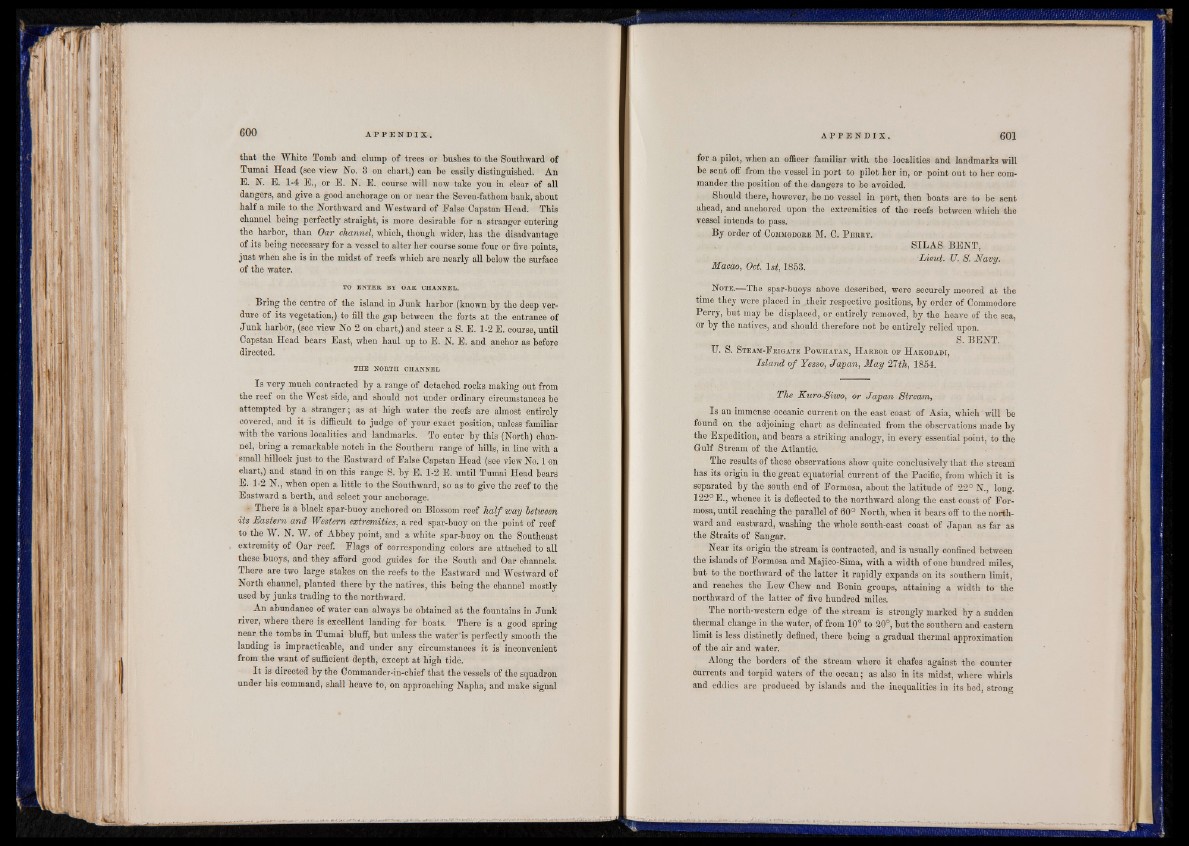
that the White Tomb and clump of trees or bushes to the Southward of
Tumai Head (see view No. 3 on chart,) can be easily distinguished. An
E. N. E. 1-4 E., or E. N. E. course will now take you in clear of all
dangers, and give a good anchorage on or near the Seven-fathom bank, about
half a mile to the Northward and Westward of False Capstan Head. This
channel being perfectly straight, is more desirable for a stranger entering
the harbor, than Oar channel, which, though wider, has the disadvantage
of its being necessary for a vessel to alter her course some four or five points,
just when she is in the midst of reefs which are nearly all below the surface
of the water.
TO ENTER BY OAR CHANNEL.
. Bring the centre of the island in Junk harbor (known by the deep verdure
of its vegetation,) to fill the gap between the forts at the entrance of
Junk harbor, (see view No 2 on chart,) and steer a S. E. 1-2 E. course, until
Capstan Head bears East, when haul up to E. N. E. and anchor as before
directed.
THE NORTH CHANNEL
Is very much contracted by a range of detached rocks making out from
the reef on the West side, and should not under ordinary circumstances be
attempted by a stranger; as at high water the reefs are almost entirely
covered, and it is difficult to judge of your exact position, unless familiar
with the various localities and landmarks. To enter by this (North) channel,
bring a remarkable notch in the Southern range of hills, in line with a
small hillock just to the Eastward of False Capstan Head (see view No. 1 on
chart,) and stand in on this range S. by E. 1-2 E. until Tumai Head bears
E. 1-2 N., when open a little to the Southward, so as to give the reef to the
Eastward a berth, and select your anchorage.
There is a black spar-buoy anchored on Blossom reef h a lf way between
its Eastern and Western extremities, a red spar-buoy on the point of reef
to the W. N. W. of Abbey point, and a white spar-buoy on the Southeast
extremity of Oar reef. Flags of corresponding colors are attached to all
these buoys, and they afford good guides for the South and Oar channels.
There are two large stakes on the reefs to the Eastward and Westward of
North channel, planted there by the natives, this being the channel mostly
used by junks trading to the northward.
An abundance of water can always be obtained at the fountains in Junk
river, where there is excellent landing. for boats. There is a good spring
near the tombs in Tumai bluff, but unless the water'is perfectly smooth the
landing is impracticable, and under any circumstances it is inconvenient
from the want of sufficient depth, except at high tidé.
I t is directed by the Commander-in-chief that the vessels of the squadron
under his command, shall heave to, on approaching Napha, and make signal
for a pilot, when an officer familiar with the localities and landmarks will
be sent off from the vessel in port to pilot her in, or point out to her commander
the position of the dangers to be avoided.
Should there, however, be no vessel in port, then boats are to be sent
ahead, and anchored upon the extremities of the reefs between which the
vessel intends to pass.
By order of C om m o do re M. C. P e r r y .
SILAS BENT,
_ Lieut. U. S. Navy.
Macao, Oct. 1st, 1853.
N o t e .— The spar-buoys above described, were securely moored at the
time they were placed in their respective positions, by order of Commodore
Perry, but may be displaced, or entirely removed, by the heave of the sea,
or by the natives, and should therefore not be entirely relied upon.
S. BENT.
U . S . S t e a m - F r ig a t e P o w h a t a n , H a r b o r o f H a k o d a d i ,
Island o f Yesso, Japan, May 21th, 1854.
The Kuro-Siwo, or Japan Stream,
Is an immense oceanic current on the east coast of Asia, which will be
found on the adjoining chart as delineated from the observations made by
the Expedition, and bears a striking analogy, in every essential point, to the
Gulf Stream of the Atlantic.
The results of these observations show quite conclusively that the stream
has its origin in the great equatorial current of the Pacific, from which it is
separated by the south end of Formosa, about the latitude of 22° N., long.
122° E., whence it is deflected to the northward along the east coast of Formosa,
until reaching the parallel of 60° North, when it bears off to the northward
and eastward, washing the whole south-east coast of Japan as far as
the Straits of Sangar.
Near its origin the stream is contracted, and is usually confined between
the islands of Formosa and Majico-Sima, with a width of one hundred miles,
but to the northward of the latter it rapidly expands on its southern limit,
and reaches the Lew Chew and Bonin groups, attaining a width to the
northward of the latter of five hundred miles.
The north-western edge of the stream is strongly marked by a sudden
thermal change in the water, of from 10° to 20°, but the southern and eastern
limit is less distinctly defined, there being a gradual thermal approximation
of the air and water.
Along the borders of the stream where it chafes against the counter
currents and torpid waters of the ocean; as also in its midst, where whirls
and eddies are produced by islands and the inequalities in its bed, strong